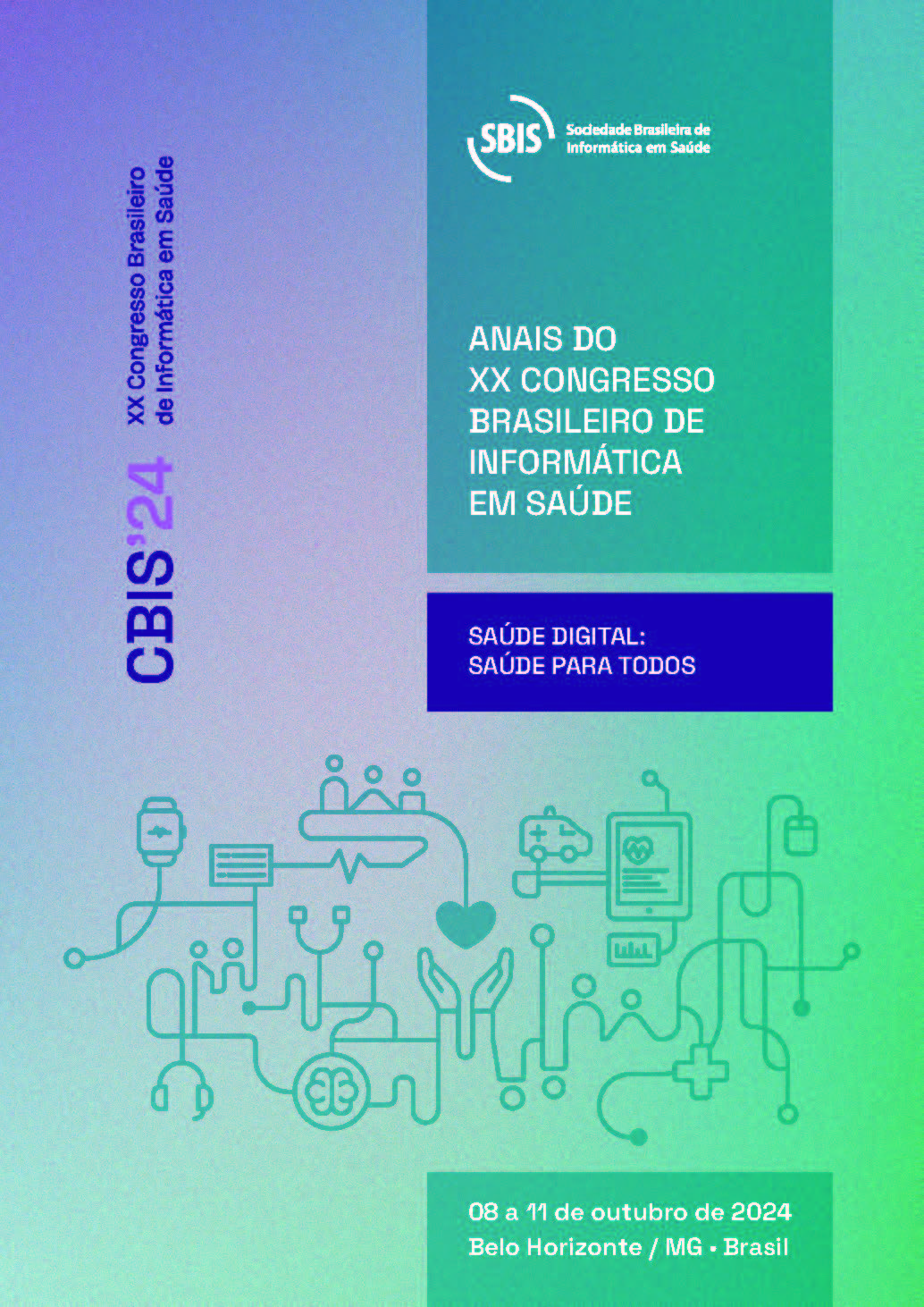Emotion Recognition as a tool to support personalized therapies
DOI:
https://doi.org/10.59681/2175-4411.v16.iEspecial.2024.1266Keywords:
Hybrid Architectures, Recognition of Emotions in Facial Expressions, Personalized TherapiesAbstract
Background: In therapeutic contexts, emotion recognition systems can be a valuable tool for patients with emotional expression difficulties. Objective: Therefore, this work aims to present a comparison between hybrid architectures to perform emotion recognition in facial expressions. Method: The proposed architectures were trained-validated with the FER2013 database and are based on Wavelet decomposition and Transfer Learning. Different data preprocessing configurations were also explored. Result: As a result, the architecture composed of a VGG16 and a Random Forest obtained 74.52% accuracy in training and 84.72% in testing, with only 27% of the attributes of VGG16. The DWNN architecture, with 4 layers and Random Forest, achieved 70.77% accuracy in training and 81.21% in testing, using 34% of the attributes. Conclusion: The best architecture will compose an emotion recognition system for personalizing therapies.
Downloads
References
Adyapady, R. Rashmi; Annappa, B. A comprehensive review of facial expression recognition techniques. Multimedia Systems, v. 29, n. 1, p. 73-103, 2023. DOI: https://doi.org/10.1007/s00530-022-00984-w
Khateeb, Muhammad; Anwar, Syed Muhammad; Alnowami, Majdi. Multi-domain feature fusion for emotion classification using DEAP dataset. Ieee Access, v. 9, p. 12134-12142, 2021. DOI: https://doi.org/10.1109/ACCESS.2021.3051281
Leong, Sze Chit et al. Facial expression and body gesture emotion recognition: A systematic review on the use of visual data in affective computing. Computer Science Review, v. 48, p. 100545, 2023. DOI: https://doi.org/10.1016/j.cosrev.2023.100545
Torcate, Arianne Sarmento; De Santana, Maíra Araújo; Dos Santos, Wellington Pinheiro. Emotion Recognition to Support Personalized Therapy: An Approach Based on a Hybrid Architecture of CNN and Random Forest. In: 2023 IEEE Latin American Conference on Computational Intelligence, 2023. DOI: https://doi.org/10.1109/LA-CCI58595.2023.10409408
González, Eduardo J. Santos; Mcmullen, Kyla. The design of an algorithmic modal music platform for eliciting and detecting emotion. In: 2020 8th international winter conference on brain-computer interface (bci). IEEE, 2020. p. 1-3. DOI: https://doi.org/10.1109/BCI48061.2020.9061664
Gong, Weijun et al. Enhanced spatial-temporal learning network for dynamic facial expression recognition. Biomedical Signal Processing and Control, v. 88, p. 105316, 2024. DOI: https://doi.org/10.1016/j.bspc.2023.105316
Motadi, Lesetja et al. Ai as a novel approach for exploring ccfnas in personalized clinical diagnosis and prognosis: Providing insight into the decision-making in precision oncology. In: Artificial Intelligence and Precision Oncology: Bridging Cancer Research and Clinical Decision Support. Cham: Springer Nature Switzerland, 2023. p. 73-91. DOI: https://doi.org/10.1007/978-3-031-21506-3_4
Ferreira, Cyntia Diógenes; Torro-Alves, Nelson. Reconhecimento de emoções faciais no envelhecimento: uma revisão sistemática. Universitas Psychologica, v. 15, p. 1-12, 2016. DOI: https://doi.org/10.11144/Javeriana.upsy15-5.refe
Teh, Elizabeth J.; Yap, Melvin J.; Rickard Liow, Susan J. Emotional processing in autism spectrum disorders: Effects of age, emotional valence, and social engagement on emotional language use. Journal of autism and developmental disorders, v. 48, p. 4138-4154, 2018. DOI: https://doi.org/10.1007/s10803-018-3659-x
Bernieri, G., & Duarte, J. C. (2023). Identifying Alzheimer’s Disease Through Speech Using Emotion Recognition. Journal of Health Informatics, 15 (Especial). https://doi.org/10.59681/2175-4411.v15.
Grondhuis, Sabrina N. et al. Having difficulties reading the facial expression of older individuals? Blame it on the facial muscles, not the wrinkles. Frontiers in Psychology, v. 12, p. 620768, 2021. DOI: https://doi.org/10.3389/fpsyg.2021.620768
Sahoo, Goutam Kumar; Das, Santos Kumar; Singh, Poonam. Performance comparison of facial emotion recognition: a transfer learning-based driver assistance framework for in-vehicle applications. Circuits, Systems, and Signal Processing, v. 42, n. 7, p. 4292-4319, 2023. DOI: https://doi.org/10.1007/s00034-023-02320-7
Podder, Tanusree; Bhattacharya, Diptendu; Majumdar, Abhishek. Time efficient real time facial expression recognition with CNN and transfer learning. Sādhanā, v. 47, n. 3, p. 177, 2022. DOI: https://doi.org/10.1007/s12046-022-01943-x
De Freitas Barbosa, Valter Augusto et al. Deep-wavelet neural networks for breast cancer early diagnosis using mammary termographies. In: Deep learning for data analytics. Academic Press, 2020. p. 99-124. DOI: https://doi.org/10.1016/B978-0-12-819764-6.00007-7
Goodfellow, Ian J. et al. Challenges in representation learning: A report on three machine learning contests. In: Neural Information Processing: 20th International Conference, ICONIP 2013, Daegu, Korea, November 3-7, 2013. Proceedings, Part III 20. Springer berlin heidelberg, 2013. p. 117-124.
Mallat, Stephane G. Multifrequency channel decompositions of images and wavelet models. IEEE Transactions on Acoustics, speech, and signal processing, v. 37, p. 2091-2110, 1989. DOI: https://doi.org/10.1109/29.45554
Chawla, Nitesh V.. et al. SMOTE: synthetic minority over-sampling technique. Journal of artificial intelligence research, v. 16, p. 321-357 2002. DOI: https://doi.org/10.1613/jair.953
Kennedy, James; Eberhart, Russell. Particle swarm optimization. In: Proceedings of ICNN'95-international conference on neural networks. ieee, 1995. p. 1942-1948. DOI: https://doi.org/10.1109/ICNN.1995.488968
Yang, Lei et al. Facial expression recognition based on transfer learning and SVM. In: Journal of Physics: Conference Series. IOP Publishing, 2021. p. 01. DOI: https://doi.org/10.1088/1742-6596/2025/1/012015
Ab Wahab, Mohd Nadhir et al. Efficient net-lite and hybrid CNN-KNN implementation for facial expression recognition on raspberry pi. IEEE Access, v. 9, p. 134065-134080, 2021. DOI: https://doi.org/10.1109/ACCESS.2021.3113337
Gunawan, Teddy Surya et al. Development of video-based emotion recognition using deep learning with Google Colab. TELKOMNIKA (Telecommunication Computing Electronics and Control), v. 18, n. 5, p. 2463-2471, 2020. DOI: https://doi.org/10.12928/telkomnika.v18i5.16717
Downloads
Published
How to Cite
Issue
Section
License

This work is licensed under a Creative Commons Attribution-NonCommercial-ShareAlike 4.0 International License.
Submission of a paper to Journal of Health Informatics is understood to imply that it is not being considered for publication elsewhere and that the author(s) permission to publish his/her (their) article(s) in this Journal implies the exclusive authorization of the publishers to deal with all issues concerning the copyright therein. Upon the submission of an article, authors will be asked to sign a Copyright Notice. Acceptance of the agreement will ensure the widest possible dissemination of information. An e-mail will be sent to the corresponding author confirming receipt of the manuscript and acceptance of the agreement.





